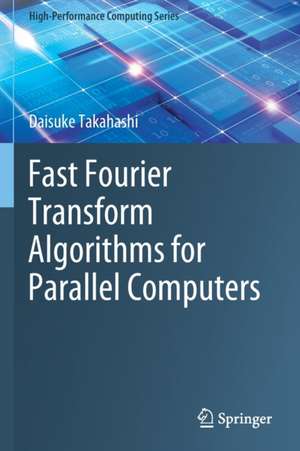Fast Fourier Transform Algorithms for Parallel Computers: High-Performance Computing Series, cartea 2
Autor Daisuke Takahashien Limba Engleză Paperback – 17 oct 2020
Following the introductory chapter, Chapter 2 introduces readers to the DFT and the basic idea of the FFT. Chapter 3 explains mixed-radix FFT algorithms, while Chapter 4 describes split-radix FFT algorithms. Chapter 5 explains multi-dimensional FFT algorithms, Chapter 6 presents high-performance FFT algorithms, and Chapter 7 addresses parallel FFT algorithms for shared-memory parallel computers. In closing, Chapter 8 describes parallel FFT algorithms for distributed-memory parallel computers.
| Toate formatele și edițiile | Preț | Express |
|---|---|---|
| Paperback (1) | 807.82 lei 6-8 săpt. | |
| Springer Nature Singapore – 17 oct 2020 | 807.82 lei 6-8 săpt. | |
| Hardback (1) | 814.07 lei 6-8 săpt. | |
| Springer Nature Singapore – 17 oct 2019 | 814.07 lei 6-8 săpt. |
Preț: 807.82 lei
Preț vechi: 1009.77 lei
-20% Nou
Puncte Express: 1212
Preț estimativ în valută:
154.59€ • 160.48$ • 128.91£
154.59€ • 160.48$ • 128.91£
Carte tipărită la comandă
Livrare economică 22 martie-05 aprilie
Preluare comenzi: 021 569.72.76
Specificații
ISBN-13: 9789811399671
ISBN-10: 9811399670
Pagini: 114
Ilustrații: IX, 114 p. 32 illus.
Dimensiuni: 155 x 235 mm
Greutate: 0.19 kg
Ediția:1st ed. 2019
Editura: Springer Nature Singapore
Colecția Springer
Seria High-Performance Computing Series
Locul publicării:Singapore, Singapore
ISBN-10: 9811399670
Pagini: 114
Ilustrații: IX, 114 p. 32 illus.
Dimensiuni: 155 x 235 mm
Greutate: 0.19 kg
Ediția:1st ed. 2019
Editura: Springer Nature Singapore
Colecția Springer
Seria High-Performance Computing Series
Locul publicării:Singapore, Singapore
Cuprins
Chapter 1: Introduction.- Chapter 2: Fast Fourier Transform.- Chapter 3: Mixed-Radix FFT Algorithms.- Chapter 4: Split-Radix FFT Algorithms.- Chapter 5: Multidimensional FFT Algorithms.- Chapter 6: High-Performance FFT Algorithms.- Chapter 7: Parallel FFT Algorithms for Shared-Memory Parallel Computers.- Chapter 8: Parallel FFT Algorithms for Distributed-Memory Parallel Computers.
Recenzii
“This well-written book can serve as useful reference for graduate students and engineers.” (Manfred Tasche, zbMATH 1477.65005, 2022)
Notă biografică
Daisuke Takahashi received his B.E. and M.E. degrees in Information and Computer Sciences from Toyohashi University of Technology in 1993 and 1995, respectively, and his Ph.D. in Information Science from the University of Tokyo in 1999. He was a research associate at the Computer Centre, University of Tokyo from 1997 to 2000, and at the Graduate School of Science and Engineering, Saitama University from 2000 to 2001. He joined the University of Tsukuba in 2001, where he is currently a Professor at the Center for Computational Sciences. His primary research interest is in high-performance computing. In 2011 he was a member of the team that won the ACM Gordon Bell Prize (Sustained Performance Prize). He is a member of the ACM, IEEE, SIAM, IPSJ and JSIAM.
Textul de pe ultima copertă
Following an introduction to the basis of the fast Fourier transform (FFT), this book focuses on the implementation details on FFT for parallel computers. FFT is an efficient implementation of the discrete Fourier transform (DFT), and is widely used for many applications in engineering, science, and mathematics. Presenting many algorithms in pseudo-code and a complexity analysis, this book offers a valuable reference guide for graduate students, engineers, and scientists in the field who wish to apply FFT to large-scale problems.Parallel computation is becoming indispensable in solving the large-scale problems increasingly arising in a wide range of applications. The performance of parallel supercomputers is steadily improving, and it is expected that a massively parallel system with hundreds of thousands of compute nodes equipped with multi-core processors and accelerators will be available in the near future. Accordingly, the book also provides up-to-date computational techniques relevant to the FFT in state-of-the-art parallel computers. Following the introductory chapter, Chapter 2 introduces readers to the DFT and the basic idea of the FFT. Chapter 3 explains mixed-radix FFT algorithms, while Chapter 4 describes split-radix FFT algorithms. Chapter 5 explains multi-dimensional FFT algorithms, Chapter 6 presents high-performance FFT algorithms, and Chapter 7 addresses parallel FFT algorithms for shared-memory parallel computers. In closing, Chapter 8 describes parallel FFT algorithms for distributed-memory parallel computers.
Caracteristici
Provides implementation details on FFTs for parallel computers Features a wealth of program examples in pseudo-code The first book exclusively focused on this topic

